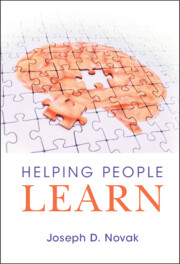Book contents
- Helping People Learn
- Helping People Learn
- Copyright page
- Contents
- Figures
- Preface
- Chapter 1 Developing the Foundations to Help People Learn
- Chapter 2 The Invention and Use of CmapTools Software in Schools, Corporations, and Other Organizations
- Chapter 3 Building a Theory of Education
- Chapter 4 The Design of Better Instructional Programs
- Chapter 5 A Look to the Future
- Book part
- References
- Index
Chapter 2 - The Invention and Use of CmapTools Software in Schools, Corporations, and Other Organizations
Published online by Cambridge University Press: 16 June 2022
- Helping People Learn
- Helping People Learn
- Copyright page
- Contents
- Figures
- Preface
- Chapter 1 Developing the Foundations to Help People Learn
- Chapter 2 The Invention and Use of CmapTools Software in Schools, Corporations, and Other Organizations
- Chapter 3 Building a Theory of Education
- Chapter 4 The Design of Better Instructional Programs
- Chapter 5 A Look to the Future
- Book part
- References
- Index
Summary
The chapter begins with a description of the first chance experience that shaped the future of my career, a meeting with a former Cornell PhD student, Bruce Dunn, who was interested in collaborating on research and invited me to do a sabbatical leave at the University of West Florida in 1987-1988. This in turn led to conversation with Dunn’s friend, Kenneth Ford, a new faculty member interested in artificial intelligence. We found that the use of concept mapping was highly facilitated for capturing expert knowledge in a fashion that rendered the knowledge easily applied in artificial intelligence settings. Ford became the director of the Institute for Human and Machine Cognition (IHMC) and he invited his friend, Alberto Cañas, to serve as associate director and to lead a team to create computer software for making concept maps electronically. We soon had available to us software that would work on almost any computer and that would not only allow the construction of concept maps, but also permit attaching digital resources to any map that could be accessed by simply clicking on icons on individual concepts. The software suite created became known as CmapTools, and this software suite is now used all over the world in virtually every field where organized knowledge is important.
Keywords
- Type
- Chapter
- Information
- Helping People Learn , pp. 42 - 72Publisher: Cambridge University PressPrint publication year: 2022



